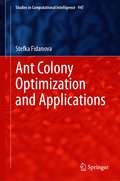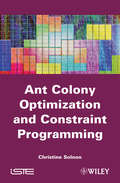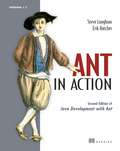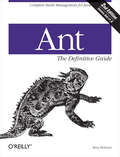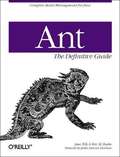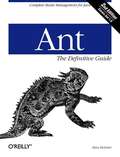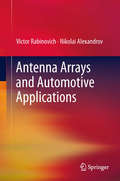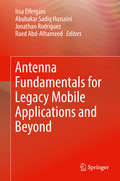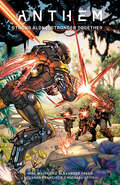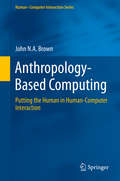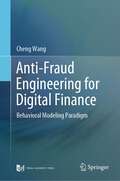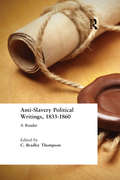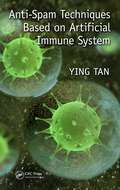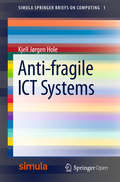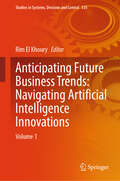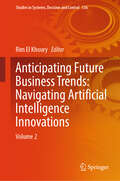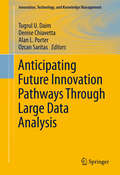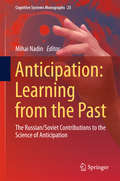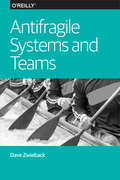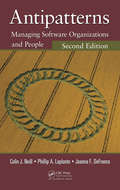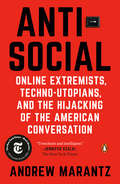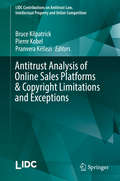- Table View
- List View
Ant Colony Optimization and Applications (Studies in Computational Intelligence #947)
by Stefka FidanovaThis book is interesting and full of new ideas. It provokes the curiosity of the readers. The book targets both researchers and practitioners. The students and the researchers will acquire knowledge about ant colony optimization and its possible applications as well as practitioners will find new ideas and solutions of their combinatorial optimization and decision-making problems. Ant colony optimization is between the best method for solving difficult optimization problems arising in real life and industry. It has obtained distinguished results on some applications with very restrictive constraints. The reader will find theoretical aspects of ant method as well as applications on a variety of problems. The following applications could be mentioned: multiple knapsack problem, which is an important economical problem; grid scheduling problem; GPS surveying problem; E. coli cultivation modeling; wireless sensor network positioning; image edges detection; workforce planning.
Ant Colony Optimization and Constraint Programming (Wiley-iste Ser.)
by Christine SolnonAnt colony optimization is a metaheuristic which has been successfully applied to a wide range of combinatorial optimization problems. The author describes this metaheuristic and studies its efficiency for solving some hard combinatorial problems, with a specific focus on constraint programming. The text is organized into three parts. The first part introduces constraint programming, which provides high level features to declaratively model problems by means of constraints. It describes the main existing approaches for solving constraint satisfaction problems, including complete tree search approaches and metaheuristics, and shows how they can be integrated within constraint programming languages. The second part describes the ant colony optimization metaheuristic and illustrates its capabilities on different constraint satisfaction problems. The third part shows how the ant colony may be integrated within a constraint programming language, thus combining the expressive power of constraint programming languages, to describe problems in a declarative way, and the solving power of ant colony optimization to efficiently solve these problems.
Ant in Action: Second Edition of Java Development with Ant
by Erik Hatcher Steve LoughranThis second edition of a Manning bestseller has been revised and re-titled to fit the 'In Action' Series by Steve Loughran, an Ant project committer. Ant in Action introduces Ant and how to use it for test-driven Java application development. Ant itself is moving to v1.7, a major revision, at the end of 2006 so the timing for the book is right. A single application of increasing complexity, followed throughout the book, shows how an application evolves and how to handle the problems of building and testing. Reviewers have praised the book's coverage of large-projects, Ant's advanced features, and the details and depth of the discussion-all unavailable elsewhere.This is a major revision with the second half of the book completely new, including:How to Manage Big projectsLibrary managementEnterprise JavaContinuous integrationDeploymentWriting new Ant tasks and datatypes Purchase of the print book comes with an offer of a free PDF, ePub, and Kindle eBook from Manning. Also available is all code from the book.
Ant: Complete Build Management for Java
by Steve HolznerSoon after its launch, Ant succeeded in taking the Java world by storm, becoming the most widely used tool for building applications in Java environments. Like most popular technologies, Ant quickly went through a series of early revision cycles. With each new version, more functionality was added, and more complexity was introduced. Ant evolved from a simple-to-learn build tool into a full-fledged testing and deployment environment.Ant: The Definitive Guide has been reworked, revised and expanded upon to reflect this evolution. It documents the new ways that Ant is being applied, as well as the array of optional tasks that Ant supports. In fact, this new second edition covers everything about this extraordinary build management tool from downloading and installing, to using Ant to test code. Here are just of a few of the features you'll find detailed in this comprehensive, must-have guide:Developing conditional builds, and handling error conditionsAutomatically retrieving source code from version control systemsUsing Ant with XML filesUsing Ant with JavaServer Pages to build Web applicationsUsing Ant with Enterprise JavaBeans to build enterprise applicationsFar exceeding its predecessor in terms of information and detail, Ant: The Definitive Guide, 2nd Edition is a must-have for Java developers unfamiliar with the latest advancements in Ant technology. With this book at your side, you'll soon be up to speed on the premiere tool for cross-platform development.Author Steve Holzner is an award-winning author who s been writing about Java topics since the language first appeared; his books have sold more than 1.5 million copies worldwide.
Ant: The Definitive Guide
by Eric M. Burke Jesse E. TillyAnt is the premier build-management tool for Java environments. Ant is part of Jakarta, the Apache Software Foundation?s open source Java project repository. Ant is written entirely in Java, and is platform independent. Using XML, a Java developer describes the modules involved in a build, and the dependencies between those modules. Ant then does the rest, compiling components as necessary in order to build the application.
Ant: The Definitive Guide, 2nd Edition
by Steve HolznerAs the most widely used tool for cross-platform development, Ant has undergone a number of important changes in its functionality and use since its launch. Ant: The Definitive Guide , 2nd Edition has been reworked to reflect these changes for Java developers everywhere. Topics covered include everything from downloading and installing, to using Ant to build Web applications, to using Ant to test code.
Ant: The Definitive Guide, 2nd Edition
by Steve HolznerSoon after its launch, Ant succeeded in taking the Java world by storm, becoming the most widely used tool for building applications in Java environments. Like most popular technologies, Ant quickly went through a series of early revision cycles. With each new version, more functionality was added, and more complexity was introduced. Ant evolved from a simple-to-learn build tool into a full-fledged testing and deployment environment. Ant: The Definitive Guide has been reworked, revised and expanded upon to reflect this evolution. It documents the new ways that Ant is being applied, as well as the array of optional tasks that Ant supports. In fact, this new second edition covers everything about this extraordinary build management tool from downloading and installing, to using Ant to test code. Here are just of a few of the features you'll find detailed in this comprehensive, must-have guide: Developing conditional builds, and handling error conditions Automatically retrieving source code from version control systems Using Ant with XML files Using Ant with JavaServer Pages to build Web applications Using Ant with Enterprise JavaBeans to build enterprise applications Far exceeding its predecessor in terms of information and detail, Ant: The Definitive Guide , 2nd Edition is a must-have for Java developers unfamiliar with the latest advancements in Ant technology. With this book at your side, you'll soon be up to speed on the premiere tool for cross-platform development. Author Steve Holzner is an award-winning author who s been writing about Java topics since the language first appeared; his books have sold more than 1.5 million copies worldwide.
Ant: The Definitive Guide, 2nd Edition
by Steven HolznerAs the most widely used tool for cross-platform development, Ant has undergone a number of important changes in its functionality and use since its launch. Ant: The Definitive Guide , 2nd Edition has been reworked to reflect these changes for Java developers everywhere. Topics covered include everything from downloading and installing, to using Ant to build Web applications, to using Ant to test code.
Antenna Arrays and Automotive Applications
by Nikolai Alexandrov Victor RabinovichThis book throws a lifeline to designers wading through mounds of antenna array patents looking for the most suitable systems for their projects. Drastically reducing the research time required to locate solutions to the latest challenges in automotive communications, it sorts and systematizes material on cutting-edge antenna arrays that feature multi-element communication systems with enormous potential for the automotive industry. These new systems promise to make driving safer and more efficient, opening up myriad applications, including vehicle-to-vehicle traffic that prevents collisions, automatic toll collection, vehicle location and fine-tuning for cruise control systems. This book's exhaustive coverage begins with currently deployed systems, frequency ranges and key parameters. It proceeds to examine system geometry, analog and digital beam steering technology (including "smart" beams formed in noisy environments), maximizing signal-to-noise ratios, miniaturization, and base station technology that facilitates in-car connectivity while on the move. An essential guide for technicians working in a fast-developing field, this new volume will be warmly welcomed as a powerful aid in their endeavors.
Antenna Fundamentals for Legacy Mobile Applications and Beyond
by Jonathan Rodriguez Issa Elfergani Abubakar Sadiq Hussaini Raed Abd-AlhameedThis book highlights technology trends and challenges that trace the evolution of antenna design, starting from 3rd generation phones and moving towards the latest release of LTE-A. The authors explore how the simple monopole and whip antenna from the GSM years have evolved towards what we have today, an antenna design that is compact, multi-band in nature and caters to multiple elements on the same patch to provide high throughput connectivity. The scope of the book targets a broad range of subjects, including the microstrip antenna, PIFA antenna, and the monopole antenna to be used for different applications over three different mobile generations. Beyond that, the authors take a step into the future and look at antenna requirements for 5G communications, which already has the 5G drive in place with prominent scenarios and use-cases emerging. They examine these, and put in place the challenges that lie ahead for antenna design, particularly in mm-Wave design. The book provides a reference for practicing engineers and under/post graduate students working in this field.
Anthem: Strong Alone, Stronger Together
by Alexander Freed Mac Walters BiowareThis prequel to BioWare's science fantasy Action RPG introduces two gifted siblings struggling for survival in a world full of danger.From the video game developer that has defined roleplaying games with seminal franchises such as Mass Effect, Dragon Age, Baldur's Gate, and Star Wars: Knights of the Old Republic comes a world brimming with new heroes, new threats, and new stories. Yarrow--one of the brave warriors known as Freelancers who pilot powerful Javelin exosuits--rescues a lone boy, Kismet, from an ambush. With no family left alive, Kismet is placed with a family in Fort Tarsis, a human outpost surrounded by untamed wilderness. His adoptive sister, Jani, struggles with Kismet's withdrawn personality at first, but over the years, the two become close friends. As they grow, Jani learns to fly and fight in Javelin armor, while Kismet trains to join the ranks of the mysterious Cyphers. The pair find themselves split, each pursuing their own craft of war, until an enemy force--large and vicious--appears on the horizon, bringing them together to face their ultimate test. They vowed to defend humanity, but can they protect each other?
Anthropology-Based Computing: Putting the Human in Human-Computer Interaction (Human–Computer Interaction Series #0)
by John N.A. BrownWe have always built tools to improve our productivity and help us lead better lives; however we find ourselves constantly battling against our new computerized tools, making us less productive and putting our health and our lives at risk. This book looks at Human-Computer Interaction (HCI) from a truly human-centred perspective; focusing on human physiology and psychology rather than the motley series of brilliant innovations, glorified mistakes, and cross-generational habits that comprise the computer-centred HCI that we practice today. This three-part guide argues that human interest and calm technology need to be at the heart of HCI. It begins by exposing the inherent dangers in past and present HCI. Using his past experiences within Anthropology, Linguistics, Education, Ergonomics, Human Factors, and Computer Science the author introduces and explores the theory of 'Anthropology-Based Computing' (ABC) as well as a new ideas like Dynamic Environmental Focus (DEF), a new model of General Human Interaction (GHI), and a new triune model of the brain: Brown's Representation of Anthropogenic Interaction in Natural Settings (BRAINS). Detailed illustrations show how HCI can be improved by considering how human bodies and brains actually work. The final part is a series of simple illustrated experiments, each applying an aspect of ABC to improve the way our computers and computerized devices treat us. Anthropology-Based Computing is written for those who work with computers, not just those who work on them. Students and researchers in Design and Psychology, and Computer Scientists as well, will benefit from seeing what is missing from the devices that are already in place, why that is, and how to make the practical changes that will immediately improve the physiological and psychological experience of using phones, on-board navigation systems, and the countless other computers we use at work and at home today and will continue to use in the future.
Anti-Differentiation and the Calculation of Feynman Amplitudes (Texts & Monographs in Symbolic Computation)
by Carsten Schneider Johannes BlümleinThis volume comprises review papers presented at the Conference on Antidifferentiation and the Calculation of Feynman Amplitudes, held in Zeuthen, Germany, in October 2020, and a few additional invited reviews. The book aims at comprehensive surveys and new innovative results of the analytic integration methods of Feynman integrals in quantum field theory. These methods are closely related to the field of special functions and their function spaces, the theory of differential equations and summation theory. Almost all of these algorithms have a strong basis in computer algebra. The solution of the corresponding problems are connected to the analytic management of large data in the range of Giga- to Terabytes. The methods are widely applicable to quite a series of other branches of mathematics and theoretical physics.
Anti-Fraud Engineering for Digital Finance: Behavioral Modeling Paradigm
by Cheng WangThis book offers an introduction to the topic of anti-fraud in digital finance based on the behavioral modeling paradigm. It deals with the insufficiency and low-quality of behavior data and presents a unified perspective to combine technology, scenarios, and data for better anti-fraud performance. The goal of this book is to provide a non-intrusive second security line, rather than replaced with existing solutions, for anti-fraud in digital finance. By studying common weaknesses in typical fields, it can support the behavioral modeling paradigm across a wide array of applications. It covers the latest theoretical and experimental progress and offers important information that is just as relevant for researchers as for professionals.
Anti-Slavery Political Writings, 1833-1860: A Reader
by C. Bradley ThompsonThe abolitionist movement in 19th century America led directly to the end of slavery in the United States. This collection of more than 20 original documents including speeches, editorials, books and fiction, captures the deep ideological divisions within the abolitionist movement.
Anti-Spam Techniques Based on Artificial Immune System
by Ying TanEmail has become an indispensable communication tool in daily life. However, high volumes of spam waste resources, interfere with productivity, and present severe threats to computer system security and personal privacy. This book introduces research on anti-spam techniques based on the artificial immune system (AIS) to identify and filter spam. It
Anti-fragile ICT Systems (Simula SpringerBriefs on Computing #1)
by Kjell Jørgen HoleThis book introduces a novel approach to the design and operation of large ICT systems. It views the technical solutions and their stakeholders as complex adaptive systems and argues that traditional risk analyses cannot predict all future incidents with major impacts. To avoid unacceptable events, it is necessary to establish and operate anti-fragile ICT systems that limit the impact of all incidents, and which learn from small-impact incidents how to function increasingly well in changing environments. The book applies four design principles and one operational principle to achieve anti-fragility for different classes of incidents. It discusses how systems can achieve high availability, prevent malware epidemics, and detect anomalies. Analyses of Netflix’s media streaming solution, Norwegian telecom infrastructures, e-government platforms, and Numenta’s anomaly detection software show that cloud computing is essential to achieving anti-fragility for classes of events with negative impacts.
Anticipating Future Business Trends: Volume 1 (Studies in Systems, Decision and Control #535)
by Rim El KhouryIn an age marked by swift technological advancements, businesses find themselves amid unparalleled challenges and opportunities. "Future Business: Anticipating Technological Trends" aims to deliver a comprehensive exploration of the dynamic technological landscape and its profound impact on the business world. This groundbreaking book intends to serve as an invaluable guide for entrepreneurs, business leaders, and innovators, providing them with the tools to anticipate and harness emerging technological trends for a competitive edge in the global market. This book represents a pioneering exploration at the confluence of technology and business evolution. In a time where everything is turning digital, the book strives to empower business leaders, entrepreneurs, and professionals with the knowledge and insights essential for navigating the ever-shifting terrain of technology and its influence on the future of business. This book sets the tone by emphasizing the critical role of technology in shaping the future of business. It will highlight the rapid pace of technological advancements and their far-reaching implications, setting the stage for a deep dive into the key trends that will define the future of business. "Future Business: Anticipating Technological Trends" promises to be an indispensable guide for those seeking to stay ahead in the competitive world of business. By providing actionable insights and strategic foresight, this book aims to empower readers to harness the full potential of emerging technologies for sustainable business success.
Anticipating Future Business Trends: Volume 2 (Studies in Systems, Decision and Control #536)
by Rim El KhouryIn an age marked by swift technological advancements, businesses find themselves amidst unparalleled challenges and opportunities. This book aims to deliver a comprehensive exploration of the dynamic technological landscape and its profound impact on the business world. This groundbreaking book intends to serve as an invaluable guide for entrepreneurs, business leaders, and innovators, providing them with the tools to anticipate and harness emerging technological trends for a competitive edge in the global market. This book represents a pioneering exploration at the confluence of technology and business evolution. In a time where everything is turning digital, the book strives to empower business leaders, entrepreneurs, and professionals with the knowledge and insights essential for navigating the ever-shifting terrain of technology and its influence on the future of business. This book sets the tone by emphasizing the critical role of technology in shaping the future of business. It highlights the rapid pace of technological advancements and their far-reaching implications, setting the stage for a deep dive into the key trends that will define the future of business. This book promises to be an indispensable guide for those seeking to stay ahead in the competitive world of business. By providing actionable insights and strategic foresight, this book aims to empower readers to harness the full potential of emerging technologies for sustainable business success.
Anticipating Future Innovation Pathways Through Large Data Analysis (Innovation, Technology, and Knowledge Management)
by Alan L. Porter Tugrul U. Daim Denise Chiavetta Ozcan SaritasThis book aims to identify promising future developmental opportunities and applications for Tech Mining. Specifically, the enclosed contributions will pursue three converging themes: The increasing availability of electronic text data resources relating to Science, Technology and Innovation (ST&I). The multiple methods that are able to treat this data effectively and incorporate means to tap into human expertise and interests. Translating those analyses to provide useful intelligence on likely future developments of particular emerging S&T targets. Tech Mining can be defined as text analyses of ST&I information resources to generate Competitive Technical Intelligence (CTI). It combines bibliometrics and advanced text analytic, drawing on specialized knowledge pertaining to ST&I. Tech Mining may also be viewed as a special form of "Big Data" analytics because it searches on a target emerging technology (or key organization) of interest in global databases. One then downloads, typically, thousands of field-structured text records (usually abstracts), and analyses those for useful CTI. Forecasting Innovation Pathways (FIP) is a methodology drawing on Tech Mining plus additional steps to elicit stakeholder and expert knowledge to link recent ST&I activity to likely future development. A decade ago, we demeaned Management of Technology (MOT) as somewhat self-satisfied and ignorant. Most technology managers relied overwhelmingly on casual human judgment, largely oblivious of the potential of empirical analyses to inform R&D management and science policy. CTI, Tech Mining, and FIP are changing that. The accumulation of Tech Mining research over the past decade offers a rich resource of means to get at emerging technology developments and organizational networks to date. Efforts to bridge from those recent histories of development to project likely FIP, however, prove considerably harder. One focus of this volume is to extend the repertoire of information resources; that will enrich FIP. Featuring cases of novel approaches and applications of Tech Mining and FIP, this volume will present frontier advances in ST&I text analytics that will be of interest to students, researchers, practitioners, scholars and policy makers in the fields of R&D planning, technology management, science policy and innovation strategy.
Anticipation: The Russian/Soviet Contributions to the Science of Anticipation (Cognitive Systems Monographs #25)
by Mihai NadinThis volume presents the work of leading scientists from Russia, Georgia, Estonia, Lithuania, Israel and the USA, revealing major insights long unknown to the scientific community. Without any doubt their work will provide a springboard for further research in anticipation. Until recently, Robert Rosen (Anticipatory Systems) and Mihai Nadin (MIND - Anticipation and Chaos) were deemed forerunners in this still new knowledge domain. The distinguished neurobiologist, Steven Rose, pointed to the fact that Soviet neuropsychological theories have not on the whole been well received by Western science. These earlier insights as presented in this volume make an important contribution to the foundation of the science of anticipation. It is shown that the daring hypotheses and rich experimental evidence produced by Bernstein, Beritashvili, Ukhtomsky, Anokhin and Uznadze, among others--extend foundational work to aspects of neuroscience, physiology, motorics, education.
Antifragile Systems and Teams
by Dave ZwiebackHow Can DevOps Make You Antifragile?All complex computer systems eventually break, despite all of the heavy-handed, bureaucratic change-management processes we throw at them. But some systems are clearly more fragile than others, depending on how well they cope with stress. In this O’Reilly report, Dave Zwieback explains how the DevOps methodology can help make your system antifragile.Systems are fragile when organizations are unprepared to handle changing conditions. As generalists adept at several roles, DevOps practitioners adjust more easily to the fast pace of change. Rather than attempt to constrain volatility, DevOps embraces disorder, randomness, and impermanence to make systems even better.This concise report covers:Why Etsy, Netflix, and other antifragile companies constantly introduce volatility to test and upgrade their systemsHow DevOps removes the schism between developers and operations, enlisting developers to deploy as well as buildUsing continual experimentation and minor failures to make critical adjustments—and discover breakthroughsHow an overreliance on measurement and automation can make systems fragileWhy sharing increases trust, collaboration, and tribal knowledgeDownload this free report and learn how the DevOps philosophy of Culture, Automation, Measurement, and Sharing makes use of changing conditions and even embarrassing mistakes to help improve your system—and your organization.Dave Zwieback has been managing large-scale, mission-critical infrastructure and teams for 17 years.
Antipatterns: Managing Software Organizations and People, Second Edition (Applied Software Engineering Series)
by Colin J. Neill Philip A. Laplante Joanna F. DeFrancoEmphasizing leadership principles and practices, Antipatterns: Managing Software Organizations and People, Second Edition catalogs 49 business practices that are often precursors to failure. This updated edition of a bestseller not only illustrates bad management approaches, but also covers the bad work environments and cultural traits commonly fou
Antisocial: Online Extremists, Techno-Utopians, and the Hijacking of the American Conversation
by Andrew MarantzFrom a rising star at The New Yorker, a deeply immersive chronicle of how the optimistic entrepreneurs of Silicon Valley set out to create a free and democratic internet--and how the cynical propagandists of the alt-right exploited that freedom to propel the extreme into the mainstream. <P><P>For several years, Andrew Marantz, a New Yorker staff writer, has been embedded in two worlds. The first is the world of social-media entrepreneurs, who, acting out of naïvete and reckless ambition, upended all traditional means of receiving and transmitting information. The second is the world of the people he calls "the gate crashers"--the conspiracists, white supremacists, and nihilist trolls who have become experts at using social media to advance their corrosive agenda. <P><P>Antisocial ranges broadly--from the first mass-printed books to the trending hashtags of the present; from secret gatherings of neo-Fascists to the White House press briefing room--and traces how the unthinkable becomes thinkable, and then how it becomes reality. Combining the keen narrative detail of Bill Buford's Among the Thugs and the sweep of George Packer's The Unwinding, Antisocial reveals how the boundaries between technology, media, and politics have been erased, resulting in a deeply broken informational landscape--the landscape in which we all now live. <P><P>Marantz shows how alienated young people are led down the rabbit hole of online radicalization, and how fringe ideas spread--from anonymous corners of social media to cable TV to the President's Twitter feed. Marantz also sits with the creators of social media as they start to reckon with the forces they've unleashed. Will they be able to solve the communication crisis they helped bring about, or are their interventions too little too late?
Antitrust Analysis of Online Sales Platforms & Copyright Limitations and Exceptions (LIDC Contributions on Antitrust Law, Intellectual Property and Unfair Competition)
by Bruce Kilpatrick Pierre Kobel Pranvera KëlleziThis book gathers international and national reports from across the globe on key questions in the field of antitrust and intellectual property.The first part discusses the application of competition law to online sales platforms, which is increasingly a focus for anti-trust authorities around the world. A detailed international report explores which are the major challenges for competition law generated by the growth of online platforms. It provides an excellent comparative study of this complex and challenging subject.The second part of the book gathers contributions from various jurisdictions on the topic “To what extent do current exclusions and limitations to copyright strike a fair balance between the rights of owners and fair use by private individuals and others ?" This section presents an international report, which offers an unparalleled comparative analysis of this topic, bringing together common themes and contrasting the various national provisions dealing with exceptions to copyright, amongst other things.The book also includes the resolutions passed by the General Assembly of the International League of Competition Law (LIDC) following a debate on each of these topics, which include proposed solutions and recommendations. The LIDC is a long-standing international association that focuses on the interface between competition law and intellectual property law, including unfair competition issues.
